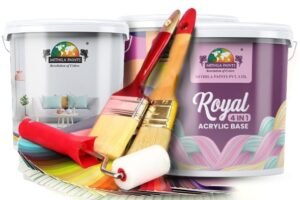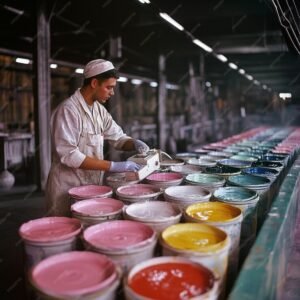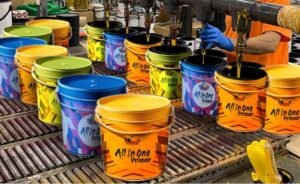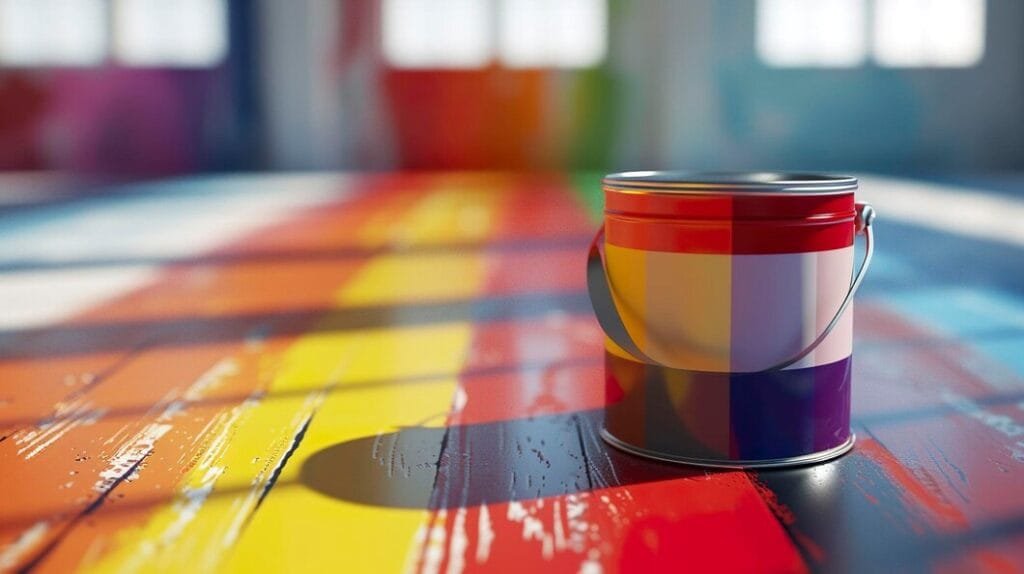Introduction to Texture Paint Manufacturing
Texture paints represent a significant category within the paint industry, distinguished by their unique ability to add depth and character to various surfaces. These paints contain additional materials that provide a textured finish, setting them apart from traditional paints. Texture paints are utilized extensively in both residential and commercial applications, enhancing the aesthetic appeal and functionality of the spaces they adorn.
The versatility of texture paints is key to their appeal. In residential settings, they are often used on walls to create dynamic backgrounds that reflect personal style. For instance, rough or stucco-like finishes can evoke a rustic charm, while smooth, raised designs may offer a contemporary touch. Homeowners leverage texture paints not just for their decorative aspects but also for their capacity to hide surface imperfections. This makes them an ideal choice in rooms where wall repairs may be necessary, as the texture can effectively camouflage flaws.
In commercial applications, texture paints are equally significant. They are commonly applied in environments that demand durability and impact resistance, such as restaurants, offices, and retail spaces. Texture finishes can also contribute to branding, as businesses often choose colors and textures that align with their brand identity. Additionally, texture paints can enhance acoustics in larger spaces, contributing to an inviting atmosphere while minimizing noise levels.
Beyond aesthetics, texture paints offer practical benefits. Many formulations are designed to be resistant to environmental factors such as moisture and UV rays, which is particularly important for exterior applications. Their varied textures can also promote slip resistance in high-traffic areas, merging safety with style. The integration of both functional and decorative characteristics positions texture paints as an invaluable resource in the toolkit of architects, designers, and homeowners alike.
The Role of Texture in Paints
Texture plays a crucial role in the formulation of paints, significantly impacting their visual appearance, tactile sensation, and overall durability. In paint manufacturing, texture refers to the surface quality created by the paint once it has dried, which can vary widely from smooth to highly textured finishes. These variations are not only pivotal in achieving aesthetic appeal but also in enhancing the functionality of the paint, catering to diverse consumer preferences.
Visually, texture contributes to depth and dimension in painted surfaces, influencing how light interacts with the paint. A smooth finish may reflect light evenly, giving a sleek, modern look, while a textured finish can create a more dynamic and engaging appearance. This can be particularly appealing in interior designs where paint is used to create focal points or to highlight architectural features. Various texture techniques, such as sponging, rag rolling, and stucco effects, allow consumers to express their individual style through their choice of paint.
Tactile sensations also play a significant part in the overall experience of using texture paints. A textured surface can evoke emotional responses and offer a sensory experience that smooth paints may not provide. Consumers often seek textures that not only look appealing but also feel engaging to the touch, thus influencing their choices during the purchasing process. Furthermore, the durability of textured paints can vary; certain textured finishes are designed to withstand harsher conditions, making them suitable for both interior and exterior applications.
Manufacturers like Mithila Paints recognize the importance of these consumer preferences and adapt their production methods accordingly. By understanding the value of texture in paint formulations, they ensure that both aesthetic and functional needs are met, ultimately influencing market trends and the development of new products.

Overview of Mithila Paints
Mithila Paints is a prominent player in the paint manufacturing industry, known for its innovative and high-quality texture paints. Founded several decades ago, Mithila Paints has built a solid reputation based on its commitment to excellence and customer satisfaction. The brand emerged with a mission to provide durable and aesthetically pleasing paint solutions that meet diverse consumer needs, specifically focusing on enhancing the visual appeal of both residential and commercial spaces.
Over the years, Mithila Paints has established a significant market presence, expanding its reach across various regions. With a comprehensive range of products, the company caters to the requirements of architects, builders, and homeowners alike. Their product portfolio includes an array of texture paints, each crafted to offer unique finishes and a myriad of colors, thereby catering to the evolving tastes and preferences of customers.
The company’s commitment to innovation is evident in its continuous investment in research and development. Mithila Paints embraces advanced manufacturing techniques and modern technologies to enhance product performance and sustainability. By focusing on eco-friendly practices, they aim to contribute positively to environmental conservation while delivering superior quality paint. Furthermore, their dedication to maintaining stringent quality control standards has positioned Mithila as a trusted brand in the industry.
Mithila Paints not only prioritizes product quality but also emphasizes customer engagement and support. Through educational initiatives and customer service, the brand strives to ensure that clients are well-informed and satisfied with their choices. This strategic approach allows Mithila Paints to not only meet but exceed customer expectations, solidifying their reputation as a leader in the texture paint sector.

Materials Used in Texture Paint Manufacturing
Texture paints are inherently distinct due to their unique compositions, which involve various raw materials. The primary components include pigments, binders, fillers, and additives, each serving a crucial function in the texture paint’s performance and aesthetic appeal.
Starting with pigments, these are integral for imparting color and opacity to the texture paint. Typically, inorganic pigments such as titanium dioxide are employed for their durability and UV resistance, ensuring that the color remains vibrant over time. Organic pigments may also be utilized, particularly for deeper hues, offering a richer palette for decorative purposes. The choice of pigment influences not only the paint’s visual characteristics but also its resistance to fading and environmental elements.
Binders are another pivotal element in the formulation of texture paints. These substances act as adhesives, ensuring that the paint adheres effectively to surfaces. Common binders include acrylics, polyurethanes, and vinyls, each contributing distinct qualities such as flexibility, water resistance, and durability. The binder type can significantly affect the texture’s finish and its ability to withstand wear and tear.
Fillers play an important role in achieving the desired texture and consistency of the paint. Materials like silica, talc, and calcium carbonate are frequently used as fillers, providing bulk to the paint while enhancing its texture. They help in controlling the viscosity and application properties, ensuring a smooth finish when applied. Additionally, fillers can aid in improving the paint’s covering power and opacity.
Finally, additives are incorporated to enhance specific performance attributes, such as drying time, anti-fungal properties, or overall durability. These chemicals ensure that the texture paint can meet various environmental and application challenges, making it suitable for both interior and exterior surfaces. Together, these materials contribute to the versatile and functional nature of texture paints, making them a preferred choice in decorative applications.

Manufacturing Methods of Texture Paints at Mithila
The manufacturing process of texture paints at Mithila Paints is a carefully curated endeavor, ensuring high-quality output that distinguishes it from competitors. The process begins with the formulation stage, where our experienced chemists meticulously design the paint composition. This includes selecting the right combination of pigments, binders, additives, and fillers that contribute to the paint’s texture, durability, and aesthetic appeal.
Once the formulation is finalized, the next step involves rigorous mixing. In this phase, the selected raw materials are blended together to achieve a homogenous consistency. Mithila Paints employs advanced mixing technology to ensure that all components are thoroughly integrated, which is vital for maintaining the uniformity of the texture paint. This stage is essential for achieving the desired texture and visual finish.
Following mixing, the paste is subjected to milling. The milling process further reduces the particle size of the raw materials, ensuring a smooth finish and refined texture. At Mithila, we utilize specialized milling equipment that enhances the quality and performance of the paint, allowing us to create products that provide superior coverage and adhesion. This innovative technique gives our texture paints a unique edge in the market.
After milling, the paste is carefully tested for quality assurance. Mithila Paints adheres to strict quality control measures at each stage of production, ensuring that the final product meets industry standards and customer expectations. Once validated, the paint is moved onto the packaging phase, where it is stored in environmentally friendly containers designed to preserve its integrity. This meticulous attention from formulation to packaging underscores Mithila Paints’ commitment to producing exceptional texture paints, ensuring that our customers receive only the best in quality and performance.
Quality Control and Testing Procedures
At Mithila Paints, the focus on quality control is paramount to ensure that every batch of texture paint meets the highest standards of consistency and safety. The manufacturing process involves several stages of rigorous testing, which are essential for achieving superior product performance. Initially, raw materials are subjected to screening procedures to verify their quality and compliance with predetermined specifications. This step ensures that only the best materials are used in the production of texture paints.
Once the manufacturing process begins, Mithila Paints implements a series of in-process quality control checks. These checks allow for the monitoring of crucial parameters such as viscosity, density, and pH levels. Such measurements are vital as they directly impact the texture and application properties of the paint. By using advanced testing equipment, the production team can intervene promptly should any deviations from the established standards occur, thereby maintaining a high level of product integrity.
After the production phase, finished products undergo comprehensive testing to assess texture, durability, and adhesion. These tests are conducted in controlled environments to simulate various application scenarios and are designed to determine how well the paint adheres to surfaces, its resistance to wear over time, and its overall aesthetic appeal. Furthermore, Mithila Paints ensures that all products comply with industry standards and regulations, which is verified through laboratory analysis and technological assessments.
The commitment to quality is not merely a regulatory requirement but a core value at Mithila Paints. A dedicated quality assurance team conducts routine audits of both the manufacturing processes and the final products. This continuous monitoring serves to reinforce trust in the brand’s texture paints and guarantees that each canister delivered to customers meets their expectations for performance and safety.
Sustainability Practices in Texture Paint Production
Mithila Paints is committed to sustainable practices within its texture paint manufacturing processes. The company recognizes the environmental challenges associated with traditional paint production and has taken significant steps to reduce its carbon footprint, comply with regulations, and promote eco-friendliness. One of the pivotal aspects of their sustainability initiative is the use of eco-friendly materials. Mithila Paints sources raw materials that are low in volatile organic compounds (VOCs), which helps to minimize air pollution during and after application of their products. By ensuring that the paint formulations are safe for both consumers and the environment, Mithila Paints leads the way in promoting healthier living spaces.
Furthermore, Mithila Paints applies advanced waste management strategies in their production line. The company has implemented a closed-loop system that efficiently recycles waste materials generated during the manufacturing process. This not only reduces the amount of waste sent to landfills but also allows for the re-utilization of materials, supporting the principles of a circular economy. Through these initiatives, Mithila Paints showcases its dedication to minimizing the overall environmental impact of texture paint production.
In addition to using eco-friendly materials and effective waste management, Mithila Paints emphasizes energy efficiency in its manufacturing facilities. The company invests in modern technology that optimizes energy consumption, thereby reducing reliance on non-renewable energy sources. Renewable energy options, such as solar panels, are being explored to further enhance their sustainability practices. All these efforts culminate in a progressive approach to texture paint production that prioritizes environmental preservation and sustainability.

Innovations in Texture Paint Technology
The landscape of texture paint manufacturing has been significantly transformed by technological advancements in recent years, particularly at Mithila Paints. These innovations reflect a commitment to enhancing the quality, application, and functionality of texture paints, catering to both aesthetic and practical requirements of the industry. One of the primary advancements has been the development of advanced formulations that improve the paint’s durability and finish, ensuring that the textures remain intact over time while resisting environmental factors.
Mithila Paints has also embraced new application methods that facilitate smoother installations and allow for greater artistic expression. With the introduction of specialized tools and equipment, such as airless spray systems and texture rollers, the application process has become more efficient and precise. These innovations not only enhance the ease of use for applicators but also contribute to a more consistent and high-quality finish that meets the diverse demands of customers.
Furthermore, new synthetic resins and pigments have been developed in recent years, which contribute to improved color retention and fade resistance. The integration of eco-friendly materials is another notable advancement; Mithila Paints has made strides in formulating sustainable texture paints that align with environmental regulations while still providing aesthetic appeal. This capability allows consumers to make responsible choices without compromising on quality or performance.
Another key area of focus has been the enhancement of texture paint functionalities, with innovative solutions addressing issues such as anti-fungal properties and UV stability. These enhancements not only meet the expectations of consumers but also ensure longevity and ease of maintenance for painted surfaces. By continually investing in research and development, Mithila Paints exemplifies how innovation in technology can transform the texture paint industry, paving the way for better quality products that serve evolving customer needs.

Future Trends in Texture Paint Manufacturing
The landscape of texture paint manufacturing is poised for significant transformation in the coming years, driven by several key factors. As market demands continue to evolve, manufacturers must adapt their strategies to cater to a more discerning consumer base that seeks quality, sustainability, and innovation. One prominent trend is the increasing preference for eco-friendly and non-toxic formulations. As consumers become more environmentally conscious, the demand for texture paints that are safe for both the environment and human health is likely to rise. Mithila Paints is committed to developing products that meet these standards, implementing sustainable practices throughout its manufacturing processes.
Another anticipated trend involves technological advancements in the production of texture paints. Innovations such as automation, artificial intelligence, and improved blending techniques are expected to enhance efficiency, precision, and consistency. By adopting these technologies, Mithila Paints aims to streamline its operations while simultaneously improving product quality. Furthermore, the integration of advanced digital tools can facilitate customized solutions for customers, enabling the creation of bespoke textures and finishes tailored to specific aesthetic preferences.
The role of social media and online platforms in shaping consumer preferences cannot be understated. Increased visibility and accessibility to various textures and colors have empowered consumers to make informed decisions. Consequently, manufacturers like Mithila Paints must enhance their digital marketing strategies, showcasing their product range through engaging content and interactive experiences. By leveraging social media, brands can directly connect with consumers, promoting their unique offerings while addressing specific customer needs.
In conclusion, the future of texture paint manufacturing will be significantly influenced by consumer demands for sustainability, advancements in technology, and the digital landscape. Mithila Paints recognizes these trends and is dedicated to evolving its practices to remain at the forefront of the industry, ensuring continued growth and innovation. By embracing these changes, the company not only meets the expectations of today’s consumers but also positions itself for long-term success in an increasingly competitive market.


